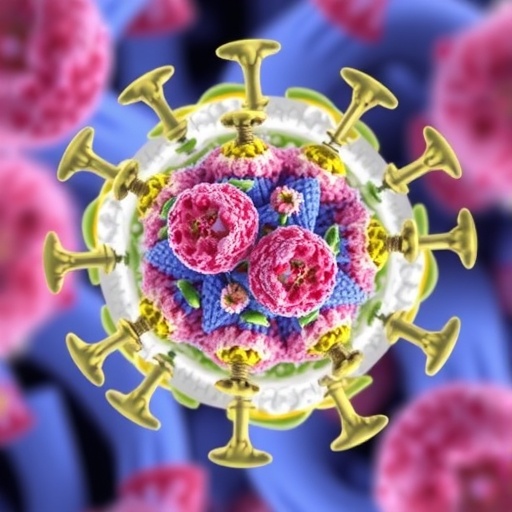In a groundbreaking advancement for the treatment of relapsed or refractory natural killer/T-cell lymphoma (R/R NKTL), researchers have unveiled a promising therapeutic approach that strategically combines epigenetic modulation with immunotherapy. This novel strategy harnesses the power of DNA methyltransferase (DNMT) inhibitors to potentiate the efficacy of anti-PD-1 immunotherapy, leveraging an intricate biological mechanism known as viral mimicry to transform so-called “cold” tumors into immunologically active, “hot” tumors. The findings, recently published in the prestigious journal Cancer Discovery, open new avenues for managing an aggressive and rare cancer subtype traditionally marked by poor prognosis and limited therapeutic options.
R/R NKTL represents a unique and challenging subtype of non-Hodgkin lymphoma, distinguished by its rarity and aggressive clinical course. Current therapeutic regimens offer limited efficacy, especially for patients who have relapsed after initial treatments or demonstrate resistance to standard approaches. Anti-PD-1 (programmed cell death protein 1) immune checkpoint blockade has emerged as a hopeful strategy by reactivating the immune system’s capacity to recognize and eradicate tumor cells. Despite encouraging responses, many patients ultimately exhibit therapeutic resistance or relapse, highlighting the urgent need to elucidate resistance mechanisms and enhance treatment modalities.
The central innovation presented by this study rests on priming the tumor microenvironment with DNMT inhibitors — drugs that reverse aberrant epigenetic silencing by inhibiting DNA methyltransferases. This epigenetic perturbation reactivates endogenous retroviral elements (ERVs), which are vestigial viral sequences inserted into the human genome through ancient infections. When re-expressed, these ERVs simulate a viral infection within the tumor cells, triggering an innate immune response termed viral mimicry. The activation of this viral mimicry pathway galvanizes the type 1 interferon signaling cascade, a crucial mediator of antiviral defense, culminating in enhanced recruitment and activation of cytotoxic CD8-positive T cells within the tumor microenvironment.
The research team, led by principal investigators Drs. Jing Tan, Huiqiang Huang, and Choon Kiat Ong, retrospectively analyzed clinical outcomes and mechanistic insights derived from 21 patients with R/R NKTL who had initially responded to anti-PD-1 therapy but subsequently developed disease progression. These patients were administered a combinational regimen of the PD-1 inhibitor sintilimab alongside one of two DNMT inhibitors — decitabine or azacitidine — both clinically established agents known for their epigenetic modulation capacities. The results were compelling: nearly half achieved complete remission, with additional patients experiencing partial responses; notably, the two-year overall survival rate was a remarkable 50.2%, a substantial improvement over historical data.
The study’s preclinical investigations using murine models underscored the molecular underpinnings of therapy resistance and reversal. DNMT inhibition effectively demethylated and reactivated ERVs within tumor cells, engendering a potent type 1 interferon response. This immunogenic cascade remodeled the tumor microenvironment, mitigating immune evasion and facilitating robust infiltration of CD8-positive cytotoxic T lymphocytes, which are essential for effective antitumor immunity. These insights establish a mechanistic rationale for combining epigenetic therapy with immune checkpoint blockade, offering a synergistic approach to overcoming immune resistance.
Clinicians and researchers alike herald these findings as a transformative step toward personalized immunotherapy in hematologic malignancies. Dr. Huang highlighted the clinical impact, noting that the observed median overall survival represented a striking improvement over previous benchmarks where patients showing progression post-PD-1 blockade typically faced median survival of only around three months. This combination therapy holds potential curative promise for a subset of patients, indicating that strategically reversing epigenetic silencing may re-sensitize tumors to immunotherapy and reshape treatment paradigms.
Further amplifying the significance of this work, the study delineates the pivotal role of viral mimicry as a therapeutic lever. By engaging ancient viral elements latent within the genome, the immune system is effectively tricked into mounting an antiviral-like assault on the tumor, sidestepping conventional mechanisms of immune suppression. This viral mimicry concept aligns with emerging evidence across diverse cancer types, where epigenetic therapies augment immunotherapeutic responses by “unmasking” tumors otherwise cloaked from immune surveillance.
However, the investigation also acknowledges substantive limitations deserving of caution and future inquiry. The retrospective design and limited patient cohort constrain the generalizability of the findings and emphasize the necessity for prospective, larger-scale clinical trials to validate efficacy and safety comprehensively. NKTL’s rarity further complicates patient recruitment and detailed tumor microenvironment profiling, which is critical for tailoring optimized combination strategies. Moreover, while the murine models recreated key features of acquired resistance observed in patients, the precise immune landscape dynamics within human NKTL tumors remain insufficiently characterized and warrant deeper exploration.
Funding from prominent scientific bodies including the National Natural Science Foundation of China and Singapore’s National Medical Research Council underscores the collaborative and international nature of this research endeavor. Importantly, the authors have declared no conflicts of interest, enhancing the credibility and objectivity of their work.
This landmark study illuminates the promising frontier where epigenetics converges with immuno-oncology, spotlighting viral mimicry as a compelling strategy to surmount immune resistance in malignancies. Beyond NKTL, the concept portends transformative potential across a spectrum of tumor types historically refractory to immunotherapy. As research evolves, refining these combination regimens and unraveling the complexities of tumor-immune interactions will be vital to unlocking broader clinical benefit.
In summary, the integration of DNMT inhibitors with anti-PD-1 antibodies inaugurates a new era in lymphoma treatment, harnessing the immune system’s intrinsic antiviral defenses to galvanize powerful antitumor activity. This innovative approach not only improves survival outcomes for a devastating cancer but also exemplifies the creative therapeutic avenues emerging at the intersection of genomics, epigenetics, and immunology. The oncology community eagerly anticipates further validation and expansion of these findings, which signify a beacon of hope for patients grappling with relapsed or refractory NK/T-cell lymphoma.
Subject of Research: Combination epigenetic therapy with anti-PD-1 immunotherapy in relapsed/refractory natural killer/T-cell lymphoma
Article Title: Priming with DNMT Inhibitors Potentiates PD-1 Immunotherapy by Triggering Viral Mimicry in Relapsed/Refractory NK/T-cell Lymphoma
News Publication Date: 15-Oct-2025
Web References: DOI: 10.1158/2159-8290.CD-25-0587
Keywords: Cancer immunology, Immunotherapy, Lymphoma




